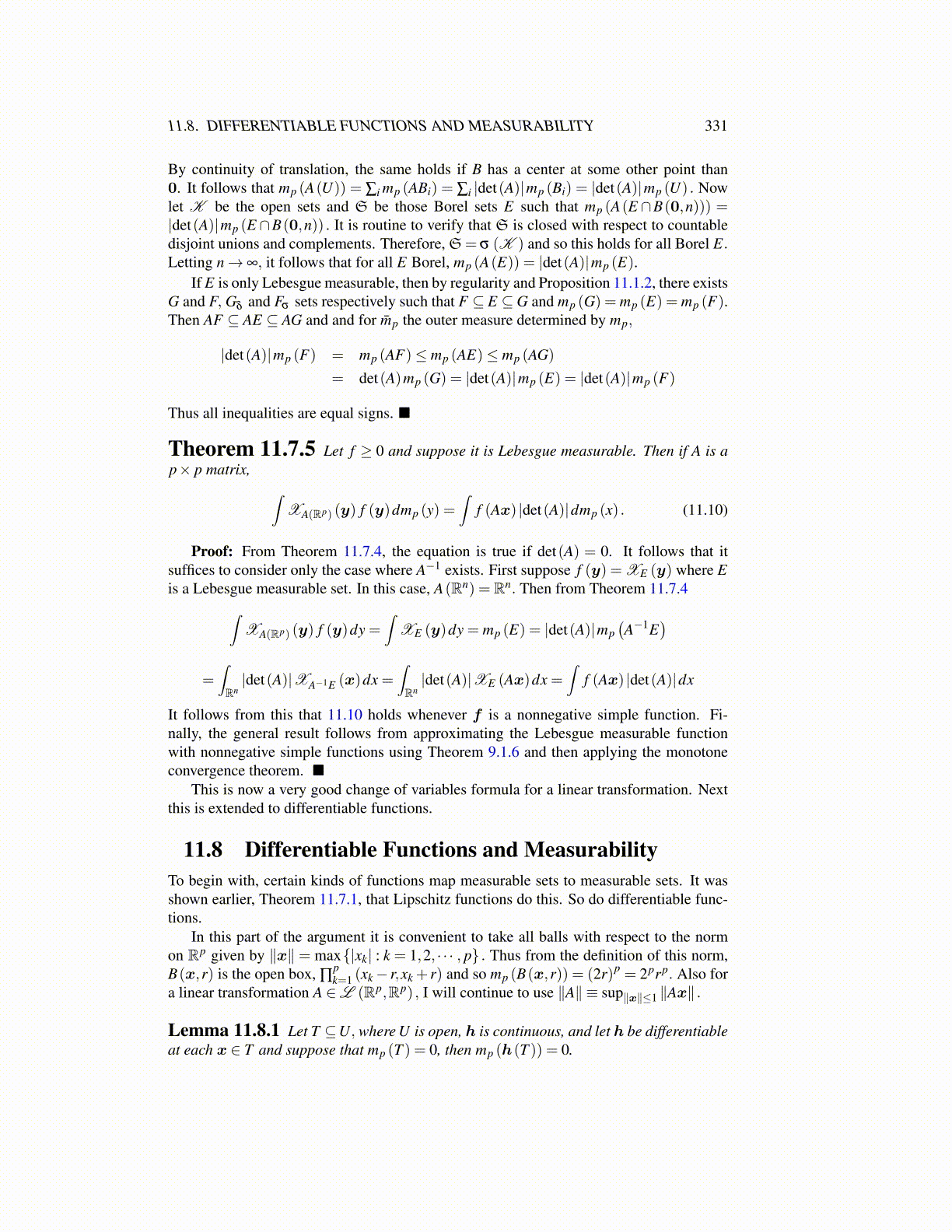
11.8. DIFFERENTIABLE FUNCTIONS AND MEASURABILITY 331
By continuity of translation, the same holds if B has a center at some other point than0. It follows that mp (A(U)) = ∑i mp (ABi) = ∑i |det(A)|mp (Bi) = |det(A)|mp (U) . Nowlet K be the open sets and S be those Borel sets E such that mp (A(E ∩B(0,n))) =|det(A)|mp (E ∩B(0,n)) . It is routine to verify that S is closed with respect to countabledisjoint unions and complements. Therefore, S= σ (K ) and so this holds for all Borel E.Letting n→ ∞, it follows that for all E Borel, mp (A(E)) = |det(A)|mp (E).
If E is only Lebesgue measurable, then by regularity and Proposition 11.1.2, there existsG and F, Gδ and Fσ sets respectively such that F ⊆ E ⊆G and mp (G) = mp (E) = mp (F).Then AF ⊆ AE ⊆ AG and and for m̄p the outer measure determined by mp,
|det(A)|mp (F) = mp (AF)≤ mp (AE)≤ mp (AG)
= det(A)mp (G) = |det(A)|mp (E) = |det(A)|mp (F)
Thus all inequalities are equal signs. ■
Theorem 11.7.5 Let f ≥ 0 and suppose it is Lebesgue measurable. Then if A is ap× p matrix, ∫
XA(Rp) (y) f (y)dmp (y) =∫
f (Ax) |det(A)|dmp (x) . (11.10)
Proof: From Theorem 11.7.4, the equation is true if det(A) = 0. It follows that itsuffices to consider only the case where A−1 exists. First suppose f (y) = XE (y) where Eis a Lebesgue measurable set. In this case, A(Rn) = Rn. Then from Theorem 11.7.4∫
XA(Rp) (y) f (y)dy =∫
XE (y)dy = mp (E) = |det(A)|mp(A−1E
)=∫Rn|det(A)|XA−1E (x)dx =
∫Rn|det(A)|XE (Ax)dx =
∫f (Ax) |det(A)|dx
It follows from this that 11.10 holds whenever f is a nonnegative simple function. Fi-nally, the general result follows from approximating the Lebesgue measurable functionwith nonnegative simple functions using Theorem 9.1.6 and then applying the monotoneconvergence theorem. ■
This is now a very good change of variables formula for a linear transformation. Nextthis is extended to differentiable functions.
11.8 Differentiable Functions and MeasurabilityTo begin with, certain kinds of functions map measurable sets to measurable sets. It wasshown earlier, Theorem 11.7.1, that Lipschitz functions do this. So do differentiable func-tions.
In this part of the argument it is convenient to take all balls with respect to the normon Rp given by ∥x∥ = max{|xk| : k = 1,2, · · · , p} . Thus from the definition of this norm,B(x,r) is the open box, ∏
pk=1 (xk− r,xk + r) and so mp (B(x,r)) = (2r)p = 2prp. Also for
a linear transformation A ∈L (Rp,Rp) , I will continue to use ∥A∥ ≡ sup∥x∥≤1 ∥Ax∥ .
Lemma 11.8.1 Let T ⊆U, where U is open, h is continuous, and let h be differentiableat each x ∈ T and suppose that mp (T ) = 0, then mp (h(T )) = 0.